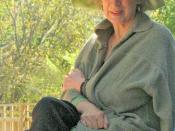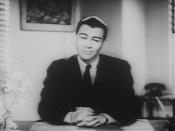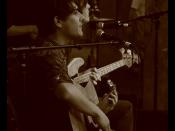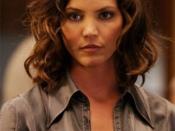This passage from CatÃÂs Eye by Margaret Atwood, illustrates the alikeness between Elaine and Cordelia by comparing the girls and the old ladies in the streetcar. Detailed descriptions of the characters contribute to highlighting different themes like friendship, disguising oneÃÂs true identity and the notion of time. These are highlighted through various literary features such as metaphor and imagery.
The passage shows a relationship between two girls, Cordelia and the narrator. They seem to be friends in the passage as it is mentioned by the narrator that ÃÂ[they] think [they] are friendsÃÂ. The phrase ÃÂwe thinkÃÂ reflects the narratorÃÂs uncertainty about her friendship with Cordelia. Yet, there are many references to them being almost twin-like and identical in the way they dress and act. ÃÂWeÃÂre impervious, we scintillate, we are thirteenÃÂ- the use and repetition of the inclusive pronoun ÃÂweÃÂ further highlights their alikeness. Even though they are friends, the reader is able to sense the narratorÃÂs inferiority to Cordelia through her tone of voice.
It is shown through her comments such as ÃÂI am almost as goodÃÂ or that Cordelia is ÃÂopaque and glintingÃÂ that the narrator admires or wants to be like Cordelia.
The detailed descriptions of the appearance of the ÃÂold ladiesÃÂ on the streetcar highlights the theme of superficiality. The descriptions show that the narratorÃÂs bias on people stems from their outer appearances, as shown in her observations such as ÃÂsome are respectably dressedÃÂ and ÃÂothers are poorer and foreign lookingÃÂ. Further, her comment that ÃÂCordelia can tell cheap cloth at a glanceÃÂ once again reinforces CordeliaÃÂs superiority and her attitude towards superficiality. These attitudes of young girls like the narrator and Cordelia convey how prejudices are deeply embedded in our society.
Metaphors like ÃÂcostumesÃÂ and ÃÂstage propsÃÂ, were used to describe peopleÃÂs willingness to disguise their true identity; ÃÂcostumesÃÂ are normally worn by actors who are impersonating someone else. Description of the old ladiesÃÂ make-up further highlights the theme of hiding a true identity of one. The ladies on the streetcar dye their hair ÃÂstraw-blonde or baby-blueÃÂ and ÃÂtheir lipstick mouths are too big around their mouths, their rouge blotchy, [and] their eyes drawn screw-jiggy around their real eyesÃÂ. Their costume-like clothes and thick make-up like actors on a stage allow them to disguise themselves from others. They reflect some members of the society who do not wish to reveal who they really are because they are afraid of what other people would think about them. These descriptive language and colour imagery invite readers to engage the narratorÃÂs experiences; bright colours to distract peopleÃÂs attention to their outer appearance. ÃÂAnything other than white is suggestiveÃÂ. Also, the two girls wearing ÃÂmenÃÂs work socks insideÃÂ their boots and wearing ÃÂ[their coats with] collars turned up to look like those of movie starsÃÂ shows their desire for glamour and outer beauty which form societyÃÂs expectation of girls.
The notion of time is another significant factor in the passage, as can be seen through its structure. The first part recounts the narratorÃÂs childhood and the second is set in her adulthood, when she herself has become like the old ladies, ÃÂhaving that [eye problems]ÃÂ nowÃÂ too. However, both the present and the past are written in the present tense, indicating that the memories of the narrator when she was thirteen still take an important part in her life. It is also mentioned at the start of the passage that ÃÂtime is not a lineÃÂ. This suggests that experiences that we had are not just past, but stays within us to build up what we are now.
This passage from CatÃÂs Eye by Margaret Atwood explores the themes of friendship, self identity and notion of time through various literary techniques. Friendship, in conjunction with the notion of time, is valued as a very big part of life of the narrator; not only the friendship, but also oneÃÂs memories of childhood are important in a personÃÂs life as well. The passage also reflects prejudices in our society and how deeply they are rooted in us through illustrating people who wish to disguise their true identity. By allowing us to explore the narratorÃÂs experiences, the author allows us to think about the values of relationships and how we can solve the problems of prejudice.
*Cat's Eye by Margaret Atwood*No bibliographies





